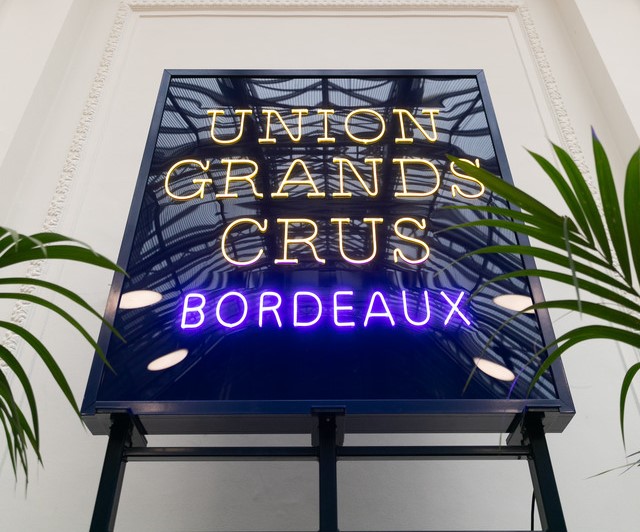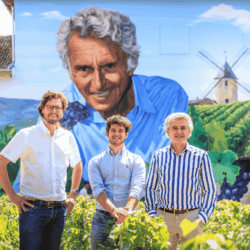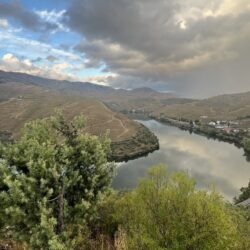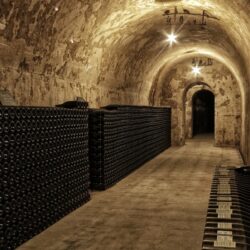2022 has been recognised as having the potential to be a spectacular vintage. Three leading Bordelais from the Union des Grands Crus de Bordeaux give us their take alongside 2016 and 2010.
It’s not often that you get to taste some of the best vintages, from the last 20 years, from Bordeaux, in one sitting. The Union des Grands Crus des Bordeaux tasting gave Sommelier Edit the chance to hear about 2022 from three leading châteaux in London, recently.
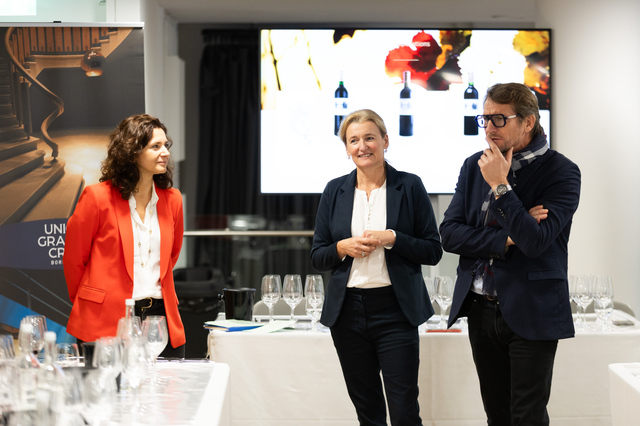
Karine Barbier, Château Lascombes, Valérie Befve, Château Dassault and Vincent Labergère, Château de Rayne Vigneau led a fascinating masterclass on, what they considered to be, three wonderful years in Bordeaux – 2010, 2016 and 2022. All members of the Union des Grands Crus de Bordeaux, these three producers represent a unique organisation comprised of132 members, across 14 Bordeaux appellations. Who better than they to explain the nuances and characteristics of great and recent Bordeaux vintages.
“Bordeaux continues to produce elegant and delicate wines,” says Karine Barbier, “2022, 2016 and 2010 are perhaps the most powerful in the last couple of decades which is why they make a interesting comparative tasting.” She continues, “They demonstrate how winemaking has changed in Bordeaux over the years; 30 to 40 years ago you could say that châteaux were more concentrated on quantity. There was much more vintage variation then, more diversity in terms of quality. In the last 20 years, thanks to innovation and adaptions with new technologies we have more consistency in the vintages.”
Valérie Befve, comments, “Technology has improved a lot. For example, my grandfather didn’t have temperature control at his finger tips, the wines were more tannic. Grapes were fermented with stems in the vats then, not many do that now. What you can say is that we are using the traditional methods to keep typicity but Bordeaux is constantly evolving.”
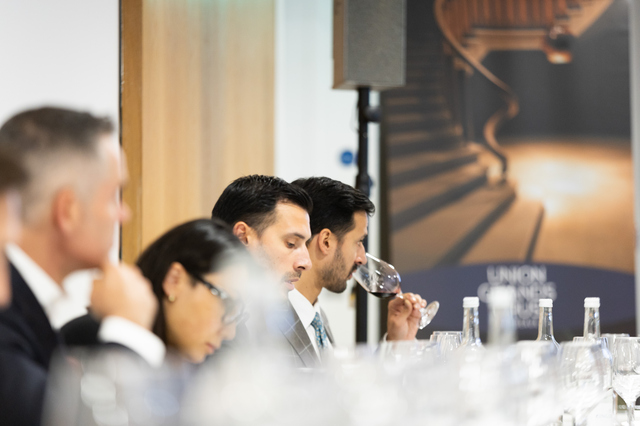
Sommelier Edit members enjoy the tasting
Within this context the key themes, such as maintaining grape acidity, managing alcohol levels and flavour, are very relevant when it come to the role of terroir in the Bordeaux style in its particular appellations. Maintaining balance between key components in their wines is crucial to preserving the Bordeaux style, Befve continues, “Terroir is the most important factor, add to that the human expertise which helps to manage the vagaries of the vintage and vine growing. All of these are then translated into the key components of the wine: acidity brings structure to the wines, alcohol needs to be in balance with that and the tannins – especially when you consider that it is rare these days to find a wine below 14% ABV in Bordeaux.”
Impact of changing climate
Speaking specifically about 2022, Vincent Labergère, adds, “Wine making in Bordeaux has always been a complex process but these days there is not a single day that goes by when we do not think about the climate, 2022 was no exception. We were certainly kept on our toes! Early frosts, hail in June and heatwaves through the summer meant that we were out in the vineyard each day checking on the vines and the fruit. This seems to be the norm now. I would say that the ’21-’24 vintages are neo-classic, we are returning to classic vintages of twenty years ago but with the benefit of expertise and technical advances that we now have our disposal.”
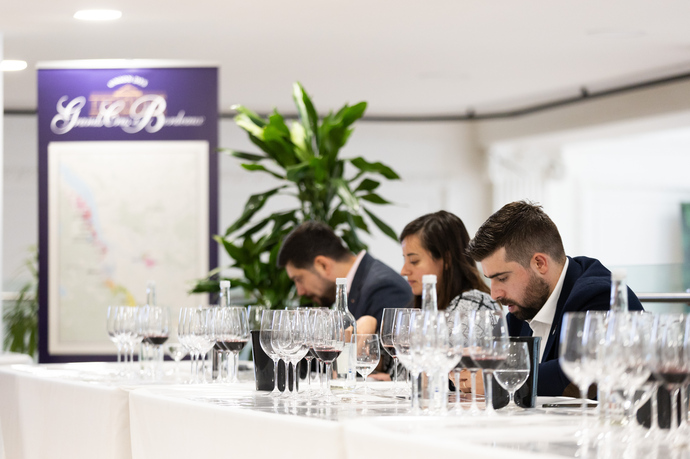
2022 vintage
The vintage started cool and dry with temperatures gradually rising through Spring to produce an early but successful bud-burst and flowering. April saw hard frosts but fortunate timing allowed the majority of the early vine growth to avoid serious damage. Hail in June cut yields, however temperatures increased and July proved to be one of the driest in years, leading to drought.
Hardly any rain fell in July and August and consecutive heatwaves were great for phenolic ripeness, but made drought management difficult. Temperatures were high – 40ºC at times – which meant that many producers had to rely on the older, more established vines which could draw on water reserves deep in the soils.
The ’21-’24 vintages are neo-classic, we are returning to classic vintages of twenty years ago but with the benefit of expertise and technical advances that we now have our disposal. Vincent Labergère, Château Rayne de Vigneau
As reported widely in the press the extreme dry and hot conditions gave way to wildfires during the summer months. Most vineyards thankfully remained untouched but smoke taint remained a worry, thanks to the ash clouds that lingered above Bordeaux. This was mainly due to the ripeness of the berries that year, however, the thick skins protected the fruit quality.
Despite an eventful vintage weather-wise, 2022 promises to be a vintage full of potential for Bordeaux.
The wines
Château Dassault, St. Emilion introduced by Valérie Befve
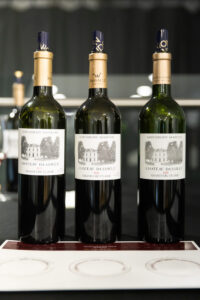
2022 – Deep, dark, almost opaque black-ruby colour with a purple rim. The aromas are earthy with black-fruit. On the palate the wine is clean, fresh blackcurrant & black-cherry fruit. The flavours are bright with attractive fine tannins and a long structured finish, underpinned by good freshness.
2016 – Medium to deep garnet-purple in colour, crushed red and blackcurrants, black berries. Plum, cedar and garrigue. Medium-bodied, the palate is vibrant and refreshing with a soft texture and loads of long-lingering black and red fruits on the finish.
2010 – Deep, dark, virtually opaque ruby-red colour. Restrained dark fruit with chalky aromas. Rich dark fruit with an angular structure & fresh acidity ensures long finish. Pronounced balanced drying oak tannins which are supple, complex. Still very young.
Château Lascombes, Margaux introduced by Karine Barbier
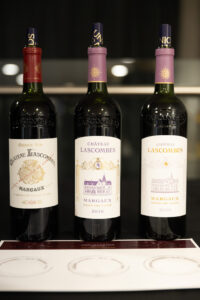
2022 – Deep, dark black-purple colour holds well to a vivid purple rim. Lifted, leafy cassis perfume with well-integrated cedar notes. The palate is fresh with juicy black-cherry notes, liquorice & concentrated fruit. Lovely freshness & balanced alcohol. Oak gives a toasty touch with juicy black-fruit to ensure good length.
2016 – Intense garnet. Elegant yet profound nose combining fresh red fruits, menthol and coffee notes. The palate is ethereal and mouth-filling with a tight-knit, fine tannin backbone. This is a very classic, clean, persistent wine.
2010 – Deep, dark opaque ruby-red colour, the rim still has a purple hue. Restrained dark fruit, lifted violet perfume on the nose. On the palate the fruit is still fresh; red-fruit nature with redcurrants & a touch of raspberry. Delicate notes of toasty oak & coffee. Mid-weight, with balanced alcohol & acidity giving freshness.
Château de Rayne Vigneau, Saurternes, introduced by Vincent Labergère
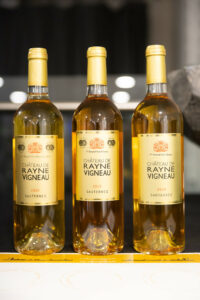
2022 – Medium to deep golden-yellow in colour. Fresh citrus notes, grapefruit with hints of vanilla, ripe stone-fruit aromas on the nose. The palate is very sweet with honeyed, sultana notes. Marzipan, rich texture on the mid-palate. The finish has fresh pineapple fruit notes, making it juicy & fresh.
2016 – White peaches, floral. Vanilla, pineapple and honey tones. Sweet but with lovely acidity giving lift for the delicious array of tropical fruits, vanilla and honey in the finish.
2010 – Still young, medium-bodied, fresh, sweet, vibrant with orange, apricot, nectarine, tangerine side all coated with honey! Solid sweetness, acidity, is sharp and wonderfully mouth-watering.

